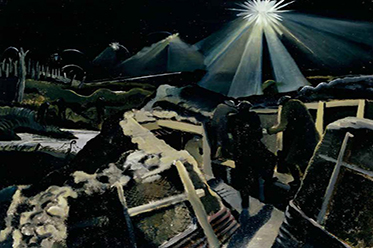 As Australia prepares to commemorate the ANZAC Centenary, history will be made in Melbourne, with the world premiere of the first ever touring exhibition from London’s famed Imperial War Museums (IWM), on show at Melbourne Museum until 4 October 2015.
As Australia prepares to commemorate the ANZAC Centenary, history will be made in Melbourne, with the world premiere of the first ever touring exhibition from London’s famed Imperial War Museums (IWM), on show at Melbourne Museum until 4 October 2015.
Using the full range of modern museum techniques – rare historic objects, extraordinary personal stories, notable works of art, dynamic audio-visual presentations, an illustrated book and bespoke multimedia iPod guide – The WW1 Centenary Exhibition aims to give 21st Century visitors a rich and engaging insight through IWM’s collection into this pivotal historical event that continues to shape all of our lives today.
The exhibition is broken down into ten story areas, which will guide visitors through the broad historical sweep of the war from its outbreak through the battlefronts on land, at sea and in the skies, to its impact on civilians back home.
This powerful and meticulously curated exhibition features over 350 rare and personal objects. From the most famous and prized items in the Imperial War Museums’ (IWM) collections, the 13-pounder Royal Horse Artillery Gun that fired the first British shot on the Western Front – to items that were once important for individual people – the jacket of typical ‘Digger’ Private Robert Tuckerman from Bendigo, Victoria, or the last photograph of English munitions worker Lottie Meade sent to IWM by her grieving husband Fred after her death.
The exhibition also includes an extensive display of art works of international reputation, including Anna Airy’s Shop for Machining 15-inch Shells, Paul Nash’s Ypres Salient at Night, William Orpen’s A Peace Conference at the Quai d’Orsay and C R W Nevinson’s post-war The Unending Cult of Human Sacrifice.
To complement these historic objects, The WW1 Centenary Exhibition has also developed a series of short, animated films to be shown on giant screens in the three central areas dealing with the war on land, in the air and at sea. They are cemented together by four more large screens that overlook the central, tall-sided area known as ‘The Trench’, intended to evoke something of the feeling of being in the trenches.
Throughout the exhibition, film, animations and soundscapes will transport visitors to the world of 100 years ago – they will encounter the people and their stories of that time. They will also see the fighting and devastation of the first global war and be able to consider how it is said to have changed the world.
World War One was an event of truly global proportions. It was the first ‘total’ war, fought on land, across the sea, beneath the waves and in the sky. It engaged not just 65 million men, from five continents and 30 countries, but whole societies that supplied and supported them.
Through its breadth and brutality the war shattered many existing ideas and realities. Empires, kingdoms and class systems all began to totter, as many people questioned their purpose and legitimacy. Some collapsed in defeat, and in their place new nations struggled into existence.
The fighting brought about the deaths of approximately 16 million servicemen and civilians. Hundreds of square miles of devastated land were left in its wake. It was no longer possible to argue that war was an acceptable form of politics: the cost in lives and destruction was too high.
Located in London, the Imperial War Museums (IWM) tells the story of people who have lived, fought and died in conflicts involving Britain and the Commonwealth since the First World War. The museum opened in 1917 while the First World War was still being fought to collect and record the stories of the millions, who lived, served and died in the war. IWM London is now home to the richest and most comprehensive WW1 collections in the world and is highly regarded as the global authority on war and conflict, from the First World War to the present day.
The WW1 Centenary Exhibition
Melbourne Museum, 11 Nicholson Street, Melbourne
Exhibition continues to Sunday 4 October 2015
Bookings: www.ww1exhibition.com.au
For more information, visit: www.ww1exhibition.com.au for details.
Image: Paul Nash, The Ypres Salient at Night, 1918 © IWM (Art.IWM ART 1145)
